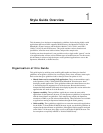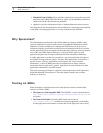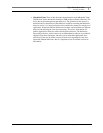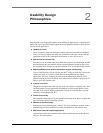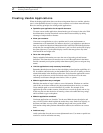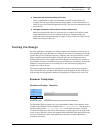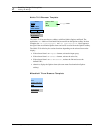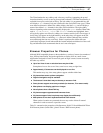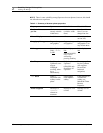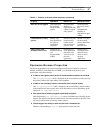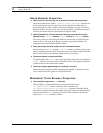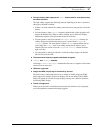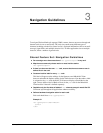
February 2001 Genie Application Style Guide 9
Usability Design Philosophies
Testing the Design
2
The Trium handset has two softkeys and a four-way scroll key (supporting the up and
down functionality, as well as moving forward and backwards). The Back functionality is
available from a press on the left scroll key. The left softkey is a programmable key and
will display a
<do> element if only one is defined for the card (which is not a prev). When
more than one element is defined, the softkey displays the label
Card and will display a
menu of the defined
<do> elements in the order of their definition. The right softkey
behaves depending on the context, but typically displays the
<prev> element. When links,
such as
<a> or <anchor>, <input> and <select> elements are highlighted, these
will typically replace one of the two softkeys on a context sensitive basis. On one type of
device, they will appear on the right hand key, on the other, they will appear on the left
hand key ONLY when no conflicting
<do> element is defined (although they could be
accessed through the four-way scroll key). Genie’s experience has shown that users
(particularly beginners) do not understand the forward and backward behavior of the scroll
key, and therefore Genie recommends that its use is not relied upon.
Browser Properties for Phones
Although WAP-compatible phones on the market have a variety of screen sizes, number of
keys, and key functionality, design the application to display well on a small screen.
Applications designed for small screens look good on larger screens, but not necessarily
the other way around.
■ Up to four lines of text or selection items may be visible.
Some phones have as few as two lines; some have as many as eight lines.
■ Approximately 15 characters can be displayed on one line.
This number may vary, since many phones support variable-width fonts.
■ All phones have menu up/down navigation.
■ Right/left navigation may be available.
■ The browser’s home deck may not be easy to access or find.
■ Some phones support smart-entry methods (for instance, T9 or smart mode).
■ Most phones can display graphics or images.
■ Not all phones have a Send/Talk key.
■ All phones support uppercase and lowercase fonts.
■ All phones support links, but phones may display them differently.
■ Most phones do not have separate Back and Clear buttons.
When queries for entries are presented, the user may need to delete all entered
characters in order to return to a previous screen.
Table 2-1 summarises the properties of the Openwave, Nokia 7110 and Mitsubishi Trium
WAP browser phones (in the table, “phone” means a WAP browser phone).



